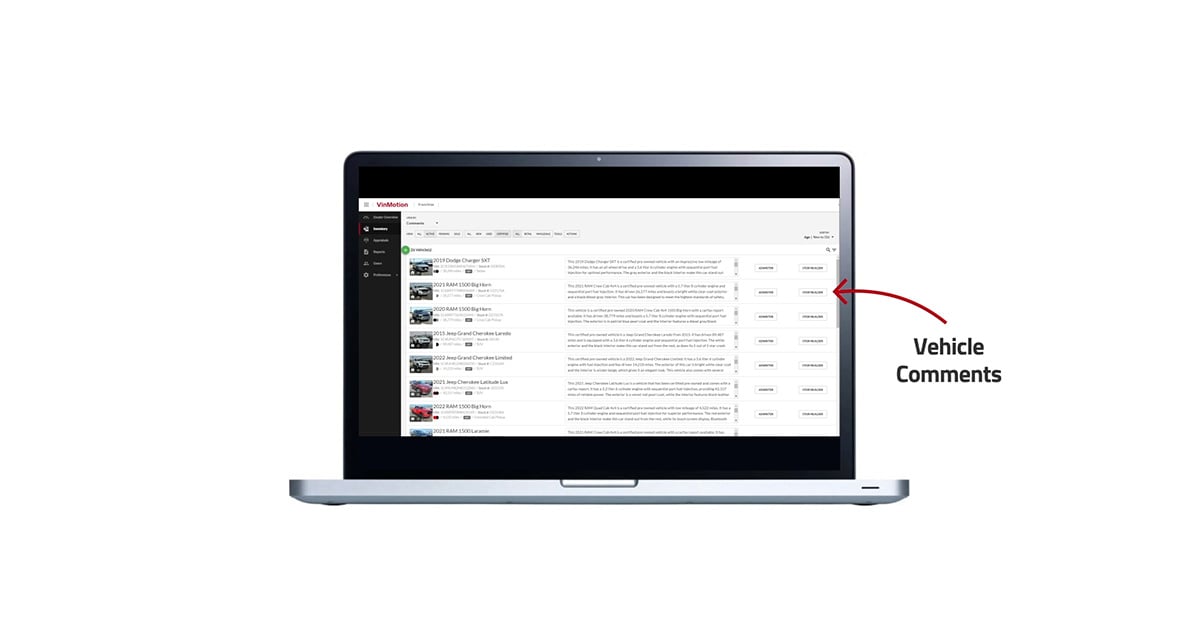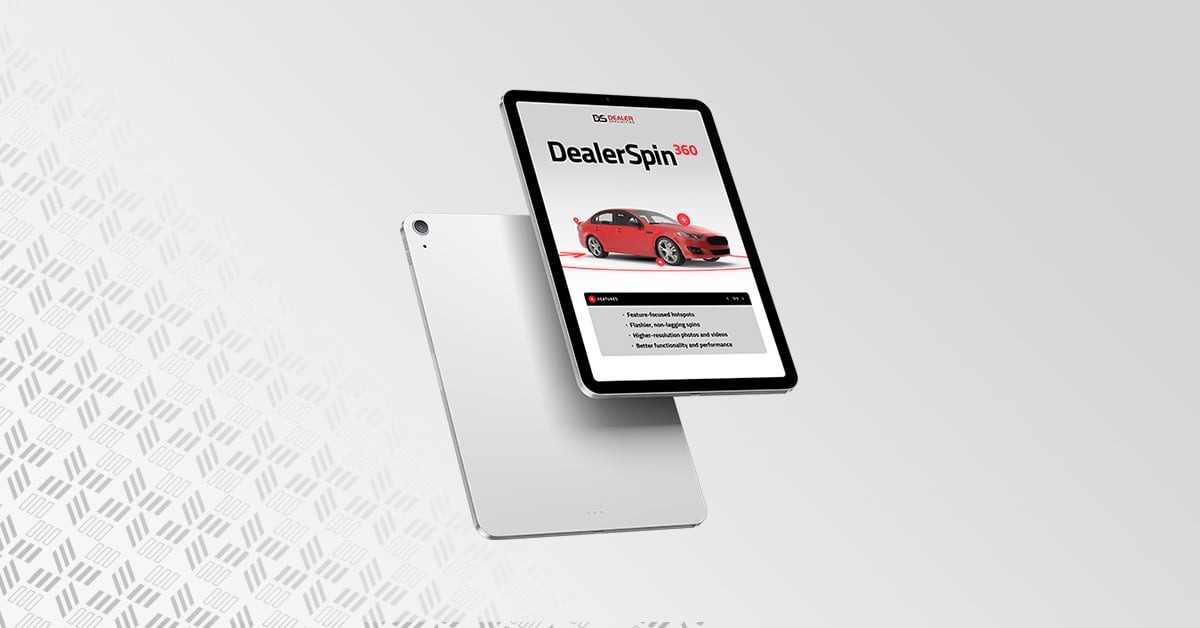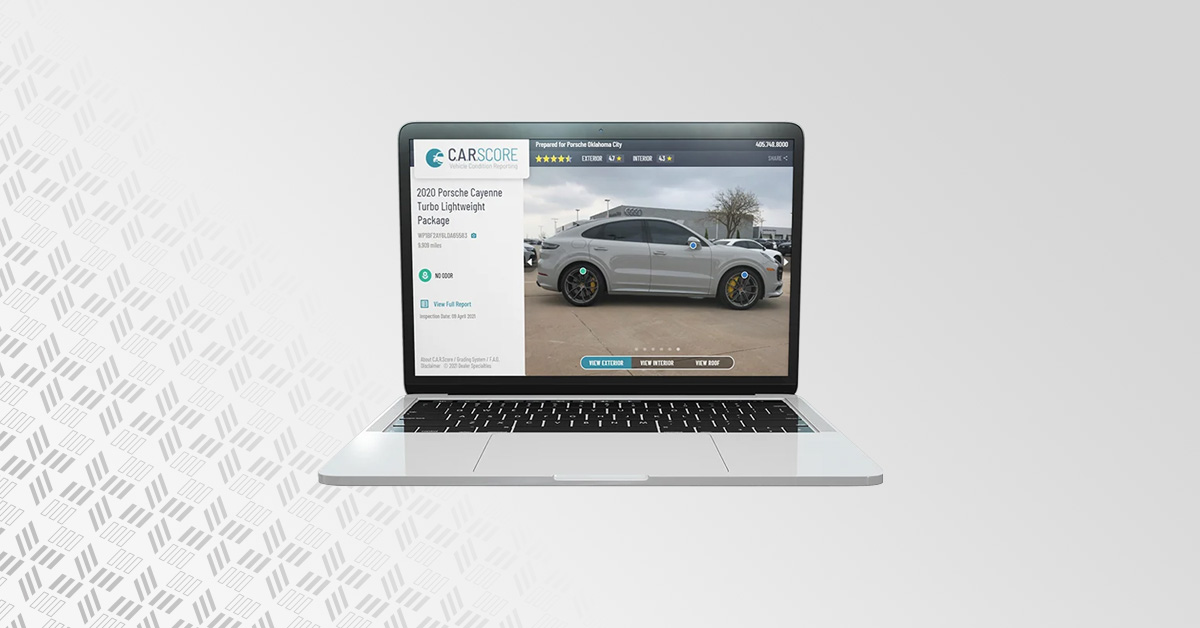15 Tips for Improving Dealership Digital Merchandising and Sales
How Does Inventory Merchandising Impact Dealership Profit Margins?
Want to take your automotive business to the next level? Ready to go from just meeting the bottom line to turning a profit month after month? Exceptional dealership merchandising is the critical piece missing from your business plan.
By optimizing how your vehicles are shown, you can attract more prospects, enhance the overall buying experience, and significantly improve your profit margins. Let's explore proven strategies to fine-tune your inventory merchandising game.
1. Invest in Automotive Inventory Management and Merchandising Systems

Dealer management systems or inventory management systems are the tools of the modern-day dealership. DMS and IMS use customized tools and resources for dealers to manage their inventory, leading to rapid vehicle turnaround and increased ROI. As management software integrates with supporting systems and websites, dealers can access a more comprehensive view of the automotive environment.
Pro Tip: When upgrading your inventory management system, focus on mobile compatibility. The ability to make quick changes to your inventory — whether pricing, photos, comments, etc. — can create efficiencies for inventory management throughout your busy day.
2. Conduct an Inventory Analysis

To improve your vehicle inventory management, you must first understand the inventory you have on your lot. This means running an inventory analysis to gather accurate information to make informed, profitable decisions. Personal estimations or gut feelings won’t work.
Conduct a regular inventory analysis with your inventory merchandising software and assess every vehicle on your lot, including incoming trades and vehicles planned for disposal.
By the end of your review, you should be able to identify these key qualities for the optimal vehicles in your inventory:
- Turnover cycle
- Average buy and sell times
- Price parameters
- Average acquisition and disposal times
3. Optimize Online Listings and Photos

Online listings serve as the primary touchpoint for potential buyers, so optimizing them for maximum impact is crucial. This includes providing accurate and detailed vehicle descriptions highlighting key features, specifications, and pricing information. Additionally, high-quality professional photographs should be used to showcase the vehicles from multiple angles, both inside and out.
4. Utilize Video and Virtual Tours

Dealerships can create engaging videos that provide a virtual tour of the vehicles to highlight their key features and benefits while keeping prospects hooked. 360-degree walkarounds can also be utilized to create immersive experiences for prospects to explore the vehicles in a more interactive and realistic manner.
Pro Tip: Need help generating video content ideas? We've got you covered. Check out our 6 Must-Try Video Content Ideas for Car Dealership Marketing.
5. Implement Live Chat or Chatbots

Live chat and chatbot functionalities can be integrated into websites and VDPs to provide instant assistance and support to potential buyers. These tools allow customers to ask questions, request additional information, and even schedule test drives, all in real time.
6. Leverage Social Media To Promote Inventory

Social media platforms, such as Facebook, Instagram, and TikTok, offer a powerful avenue for promoting their inventory where shoppers already spend their time. Share visually appealing images, videos, and customer testimonials to generate interest and attract potential buyers organically. Paid advertising campaigns can also help reach a wider audience and drive targeted traffic to websites, VDPs, and physical locations.
7. Harness AI To Simplify Your Merchandising Efforts

AI technology can streamline your inventory merchandising processes for things like automated photo editing and content generation. Modern AI tools can quickly remove photo backgrounds, enhance image quality, and process multiple photos simultaneously. For vehicle descriptions, AI generators can create unique, SEO-optimized content that highlights key features while maintaining your brand voice across all platforms.
These tools reduce manual editing time and ensure consistency across your inventory listings, allowing your team to focus on strategic sales activities rather than repetitive editing tasks.
8. Use Metrics To Guide Strategy

While adaptability is important, you don’t want to react to the market. Monitor metrics and KPIs for dealerships and use your regular inventory evaluations to conduct proactive plans for the future. For optimal performance, a proactive dealer strategy should include plans for buying and selling vehicles based on the following:
- Gross profit
- Return on investment (ROI)
- Average turnover time
- The average cost of sale
- Seasonality
- Evaluation and appraisal best practices
- Age
- Competitive pricing for your local market
9. Proper Inventory Sourcing

Getting your inventory for the right price is critical for any profitable inventory management plan. A dealership’s sourcing strategy should establish the following:
- How often wholesale vehicles are acquired
- Where wholesale vehicles are acquired
- Parameters for trade-in decisions
- Remarketing efforts
When adding vehicles to your inventory, ensure you understand their condition and the demand for the vehicle. The only thing worse than a junker you can’t sell is a clunker no one was interested in in the first place.
Whether sourcing vehicles from wholesale, trade-ins, or auctions, you must gather as much information on the car’s history as possible. That data will be invaluable for adding transparency to your website and building trust with potential buyers.
10. Know Your Vehicles' Market

If you want to understand the vehicle market instead of acting instinctually, you need accurate market data on your dealership and the competition. Tools, such as automotive marketing software, are great for market comprehension. With this data, informed decisions about ideal vehicles, price range, and key selling points, you have all the tools to source killer inventory and gain online attention.
11. Diversify Your Vehicle Inventory

Any successful business leader knows diversifying your investments is smart; the same is true about your inventory. Don’t crowd your lot with a single make or model, even if you’re a franchise owner. You could unintentionally take yourself out of consideration for buyers that are ready to change brands.
Furthermore, you could sow internal competition between used and new vehicles of the same make and model. Tracking sales by make, model, manufacturer, and more makes finding the right mix easier than ever before.
12. Utilize an Order-Based Turnover System

Thanks to your regular inventory analysis, you know what patterns of vehicles have a higher turnover than the rest of your stock. Talk with your sales and management team to discuss stocking those vehicles over other options.
However, if you discover that customers are asking for vehicles that are out of stock, take note. Listening to customer needs is crucial for determining what vehicles are worth keeping on your lot.
13. Price Vehicles With Transparency In Mind

Today’s internet users can access information on almost everything, including the vehicle market. It does no good to hide vehicle pricing behind a sales call or an in-person visit. There’s a good chance that information is on a competitor’s website. If it’s not on yours, not only is that suspicious, but you likely lost a sale to that competitor.
With digital merchandising, being transparent online is critical to building trust. Tools like C.A.R.Score make information about your vehicles' pricing, condition, and history easily accessible on your website.
Pro Tip: Transparency is just one part of improving the car buying experience. For more on this topic, check out our article on How to Improve the Car Buying Experience.
14. Price Vehicles Based on Time Spent on Lot

Prioritizing older vehicles is one of the most important things you can do to improve your inventory management. The longer a car sits on your lot, the lower the price. If you’re not careful, this can severely undercut your huge sales on new vehicles.
According to Acvauctions.com, “The best practice is to hold 50% of aged inventory for a maximum of 30 days from acquisition. All used vehicles should be sold within 45 days. If it doesn’t sell in that time, it should be wholesaled.”
Looking at that advice in practice, a fresh car might be valued at 98% of the local market. If that car doesn’t sell within two weeks, use your inventory analysis and market data to decide if dropping the price to 95% of the market value is the right choice. You can manage depreciation and focus on moving aging inventory by pricing your inventory based on time.
Pro Tip: No one wants to buy a damaged car, so invest in minor fixes when vehicles need reconditioning. Correcting obvious issues will decrease the selling time, especially for luxury vehicles.
15. Share Your Stock With Other Dealerships

If you have an abundance of a specific vehicle brand, try teaming up with other dealers selling the same brand. By pooling selections of your inventory, you can work together to make room for new vehicles you’re looking to bring onto your lot. Just ensure the dealers you partner with are close enough to justify pooling your inventory without being too close to competing with them.
Get More Digital Merchandising Advice
As a leading automotive digital merchandising partner for over 3,000 dealerships, Dealer Specialties' digital merchandising has the expertise and tools to help you stay competitive in today’s vehicle market. From interactive 360 tours to comprehensive vehicle condition reports, we offer resources that capture buyers’ interest and keep them engaged until the final point of sale.
Take five minutes to answer a few questions about your current inventory merchandising efforts, and we’ll provide more recommendations to help you drive profit.

